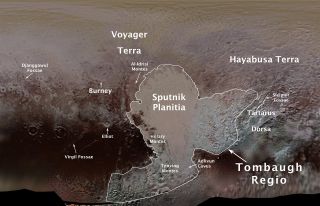
On 15 July 2015, the region was provisionally named "Tombaugh Regio" by the New Horizons team in honor of astronomer Clyde Tombaugh, the discoverer of Pluto, regio being Latin for 'region'. NASA initially referred to it as a "heart" in reference to its overall shape. Tombaugh Regio was first identified in the initial image of Pluto returned after the New Horizons probe recovered from an anomaly that temporarily sent it into safe mode. In 2020, it was found that Tombaugh Regio controlled the wind circulation of Pluto, and could sculpt the landscape on its surface. Over these six decades the spot had been observed to be dimming. The feature had been identified as a bright spot for six decades prior to the New Horizons flyby, although it was impossible to image it with enough resolution to determine its shape. The surface of Sputnik Planitia is divided into polygonal convection cells and is less than 10 million years old, indicating that Pluto is geologically active. Subsequent data indicated that the center of Sputnik Planitia is rich in nitrogen, carbon monoxide, and methane ices, and that features near the edges of the region show evidence of ice flow such as glaciers, and light material overlying the darker material at the eastern edge of Cthulhu Macula. Photos, released on 15 July 2015, revealed 3,400 m (11,000 ft) mountains made of water ice in the feature they also showed no craters in this same region. Bright spots within the region were initially speculated to be mountain peaks. Early speculation was that the western lobe may be a large impact crater filled with nitrogen snow. The western lobe, Sputnik Planitia, is smoother than the eastern, and they are of slightly different colors. The two lobes of the feature are geologically distinct. Tartarus Dorsa is a ridge named for Tartarus, the deepest, darkest pit of the underworld in Greek mythology.Tombaugh Regio is a large, light-colored region about 1,590 km (990 mi) across.Voyager Terra honours the pair of NASA spacecraft, launched in 1977, that performed the first “grand tour” of all four giant planets.Hayabusa Terra is a large land mass named in honour of the Japanese spacecraft and mission (2003-2010) that returned the first asteroid sample.

Virgil Fossae honours Virgil, one of the greatest Roman poets and Dante’s fictional guide through hell and purgatory in the Divine Comedy.Sleipnir Fossa is named for the powerful, eight-legged horse of Norse mythology that carried the god Odin into the underworld.Djanggawul Fossae defines a network of long, narrow depressions named for the Djanggawuls, three ancestral beings in indigenous Australian mythology who travelled between the island of the dead and Australia.Sputnik Planitia is a large plain named after Sputnik 1, the first space satellite, launched by the Soviet Union in 1957.Burney: The approved Pluto surface feature names include the Burney crater that honours Venetia Burney (1918-2009), who as an 11-year-old schoolgirl suggested the name “Pluto” for Clyde Tombaugh’s newly discovered planet.The Other names given to the features of Pluto are: Tenzing Montes and Hillary Montes are mountain ranges honouring Tenzing Norgay (1914-1986) and Sir Edmund Hillary (1919-2008), the Indian/Nepali Sherpa and New Zealand mountaineer who were the first to reach the summit of Mount Everest and return safely. These are the first geological features on the planet to be named following the close flyby by the New Horizons spacecraft in July 2015.


 0 kommentar(er)
0 kommentar(er)
